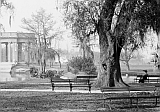|
New Orleans City Park (Images of America) |
|
|
|
~The Bayou, Road, Oaks, and Native Americans: 1400-1769~ |
||

|
The natives also
showed Bienville a log bridge across the bayou, islands in the swamp surrounding it, huge moss-laden cypress trees, palmetto,
reeds, and grasses. Along the steadily rising bank of the bayou were the oak, persimmon, pecan, cherry, acacia, and sweet
gum trees which would grace City Park – the bayou would become its eastern border. The first known people to settle
there were the Chapitoulas who lived in cypress huts which were abandoned and then used by the Biloxi tribe The Houmas also
settled along the bayou. The Acolapissa tribe named the adjoining bayou (which would be known as Bayou Metairie) “Bayou
Choupic” for the mud fish which inhabited it. A handful of colonists under French Rule (1699—1769) settled
there to grow indigo, corn, and sugar cane. Bayou St. John would become a major port of New Orleans until railroads and steam
engines made it possible to easily ply up the Mississippi but the bayou was navigable until 1936 when the WPA added low bridges.
In 1982 Bayou St. John was placed on the National Register of Historic Places and recognized as an Historic & Scenic River
(which requires protection and preservation ) by the Louisiana Legislature. : :
|
|
|
The images in this book appear courtesy of the New Orleans Public Library (NOPL), Louisiana Digital Library (LDL), the Library of Congress (LOC), The Historic New Orleans Collection (HNOC), Pictometry International (PI), and D.C. "Infrogmation" May (DCM). Unless otherwise noted, images are from the author's collection.
|
||